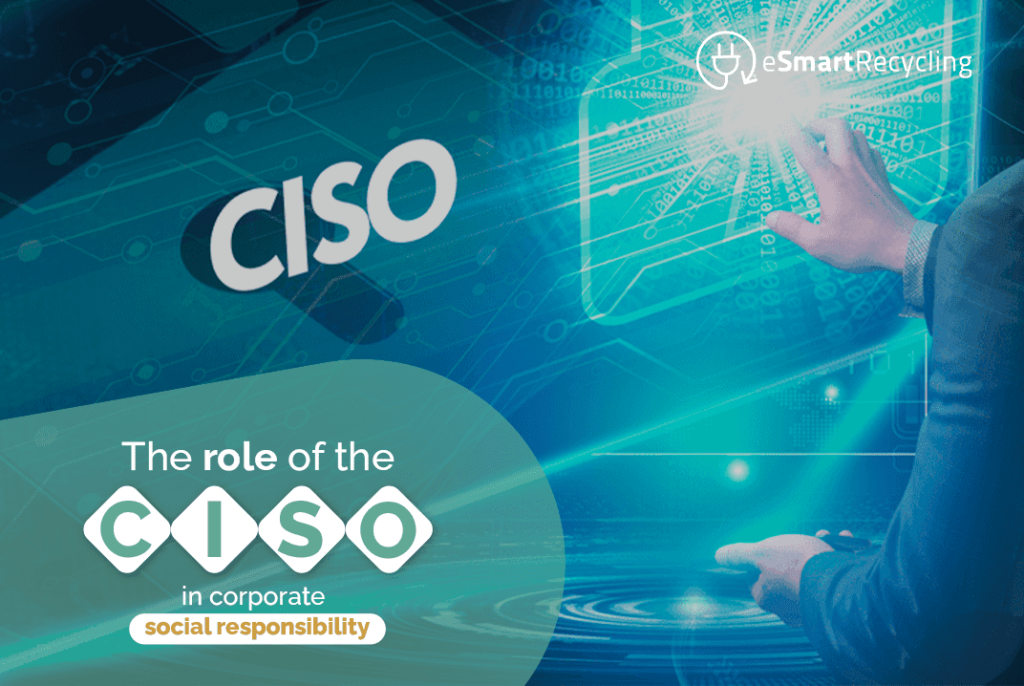
Nowadays, in times of social and political upheaval, corporate social responsibility (CSR) is more crucial than ever. This idea is making waves in the business world, with companies, both large and small, feeling the pressure to be socially responsible. With the rising expectation that C-level executives, such as the Chief Information Security Officer (CISO), play a leading role in implementing and managing CSR initiatives, the role of CISOs is evolving significantly.
This article delves into the role of the CISO in corporate social responsibility, detailing the duties and responsibilities of CISOs concerning CSR. It will identify common NIST security measures and initiatives that all CISOs should be familiar with. Additionally, the potential benefits of implementing CSR in a company, as well as possible challenges to overcome, will be discussed.
A core idea underlying corporate social responsibility is that companies should strive to operate in a way that is beneficial for society and the environment where they conduct their activities. This involves taking steps to reduce waste mitigate environmental impacts, and develop ethical business practices. Companies that adhere to CSR are often seen as more credible and trustworthy, as they are perceived to show a genuine interest in operating ethically and morally.
With this in mind, many companies are beginning to focus on developing CSR initiatives, and there is a heightened expectation for C-level executives, particularly CISOs, to play a leading role in launching and managing these initiatives. CISOs are uniquely positioned to take on this role, as they are responsible for securing the company’s sensitive data and infrastructure.
When it comes to corporate social responsibility, the role of the CISO is very similar to their role in other security aspects: identifying and managing an organization’s risks, ensuring compliance with applicable policies and standards, and providing guidance and direction to their teams. To do this effectively, a CISO needs a broad range of technical knowledge and a thorough understanding of business operations and the potential impacts posed by security measures.
CISOs are often tasked with ensuring that their company has robust risk management practices, and it’s crucial to adopt a proactive approach to identifying and managing any potential risks. They frequently apply best security practices and seek and resolve known vulnerabilities in cyberspace. Additionally, they review the company’s policies and procedures to ensure they protect both sensitive data and customer information. All these practices can be used to help establish, maintain, and ensure compliance with CSR initiatives.
CISOs need to be familiar with the National Institute of Standards and Technology’s cybersecurity framework, as this framework guides establishing and improving cybersecurity in almost any company. The NIST framework offers a holistic approach to risk management and can be used to help companies identify potential vulnerabilities and mitigate cyber-attacks. The NIST framework also provides specific guidance on addressing the implications of technologies and the development of digital infrastructures on the environment.
Implementing and maintaining CSR initiatives can offer organizations a wide range of benefits. These include improved public relations and reputation, reduced risks and vulnerabilities, increased employee engagement and retention, and enhanced financial performance. The nature of these benefits can be especially important when considering the perspective of the CISO, as much of the responsibility will fall on them to provide the guidance, leadership, and technical support needed to ensure that CSR initiatives are applied effectively and efficiently.
It should also be noted that companies adopting CSR initiatives will be more attractive to potential employees. Younger professionals, in particular, are drawn to companies that align with their values and are considered more appealing to work for.
Of course, there will always be obstacles to overcome when implementing any new initiative in a company. Regarding CSR, the main challenges revolve around the time, cost, and resources required to implement the required changes. As a result, CISOs need to secure the buy-in of senior management before committing to any CSR initiative. It’s also crucial to take the necessary time to explore any potential risks, costs, and benefits before embarking on an implementation.
The role of the CISO in corporate social responsibility is evolving significantly, and it’s important for CISOs to familiarize themselves with best practices and means to implement CSR. The NIST framework provides a solid foundation for addressing the security implications of CSR initiatives and adopting a proactive approach to identifying vulnerabilities and establishing compliance will be the primary responsibility. Given the increasing level of demand for CISOs to play a leading role in achieving corporate social and environmental responsibility, the importance of the CISO’s role in this area will continue to grow over time.
Fill out the form below to request your electronics recycling pickup.
We’ll coordinate the schedule logistics and follow up with next steps.
Recycling old tech isn’t just “getting rid of stuff.” Behind every computer, server, or phone, there are valuable materials, sensitive data, and environmental responsibilities that shouldn’t be ignored.
This guide walks you through the safe, responsible, and trackable way to recycle technology — the same process we follow every day at eSmart Recycling.
The first step is simple but essential: know what you have.
An accurate inventory helps you plan and manage the process correctly.
We do this at every corporate pickup: we audit, label, and track each asset before moving it. That ensures transparency and total control.
Before recycling, every piece of data must be erased — permanently.
At eSmart Recycling, we use certified data destruction methods that meet HIPAA and NIST 800-88 standards.
If you’re preparing devices yourself:
It’s not just about protecting information — it’s about protecting your company’s reputation and compliance.
Many electronics contain hazardous materials such as lead, mercury, or lithium.
Separating batteries, screens, cables, and circuit boards prevents accidents and makes downstream recycling safer.
In our facility, we manually disassemble and classify components to guarantee proper recovery and treatment.
Not all recyclers are the same. Work only with certified providers — ideally those with R2v3 or e-Stewards certification — and verified traceability.
A reliable recycler should offer:
At eSmart Recycling, we go a step further. Part of the recovered value from equipment is used to refurbish and donate computers to children and families who need them. That means your recycling effort also supports digital inclusion.
Once your materials are ready:
We provide both certificates, along with a full traceability report and an environmental summary.
We also offer social and environmental impact reports so companies can communicate their results transparently.
Safe tech recycling shouldn’t be a one-time project.
Set up regular collections — annually or semi-annually — and include them in your sustainability reporting.
Every year, thousands of companies in the U.S. refresh their technology. When that equipment is handled properly, it prevents pollution, reduces emissions, and helps close the digital divide.
At eSmart Recycling, that’s exactly what we do.
We collect, audit, refurbish, and recycle devices — ensuring data security, environmental safety, and social good. Refurbished computers from our process reach schools and communities that otherwise wouldn’t have access to technology.
What starts as a technical process ends up creating human change.
If your company wants to recycle safely, transparently, and with purpose, this is the way to do it.
If we want to take sustainability seriously, technology is a great place to start. Every device we use — from phones to servers — consumes resources, energy, and materials. But it also gives us a chance to use them more wisely.
Here are five practical things you can do at home or in your company to help the planet and join the spirit of World Sustainability Day 2025.
Rule number one: don’t replace, repair. Many laptops and desktops can work perfectly fine with a little upgrade — an extra stick of RAM, an SSD drive, or a new battery. Even basic maintenance like cleaning fans, can extend their life by years.
Every year, the world generates over 62 million tons of e-waste, yet only 17.4% is properly collected and recycled. Keeping your devices running longer helps reduce your piece of that growing problem.
When a replacement is really needed, go for devices with ENERGY STAR or EPEAT labels — they’re designed to use less power and last longer.
And don’t forget the small stuff:
Simple, everyday actions like these can save huge amounts of energy when multiplied across dozens of devices.
Many electronics still draw “phantom” energy even when they’re off. Smart power strips detect when a device isn’t being used and cut power to that outlet automatically.
They’re great for home offices, meeting rooms, or printing areas — a small investment that pays off quickly.
Sustainability also lives in the digital world. Try these small shifts:
Data centers consume massive amounts of electricity, and these habits help cut that footprint.
When a device truly reaches the end of its life, don’t throw it away. Partner with certified recyclers that guarantee secure data destruction and proper material recovery.
In 2025, North America’s e-waste recycling market is valued at over $33 billion, and it keeps growing worldwide.
At eSmart Recycling, we handle this process every day — collecting, auditing, refurbishing, and recycling technology. Every device that gets a second life helps reduce waste and connects more people to digital access.
If everyone adopted just two or three of these actions, the difference would be massive. Let’s make tech sustainability part of everyday life — not just a buzzword.
Managing electronic waste responsibly isn’t just about protecting the environment — it’s a solid, long-term business move. Here’s why, backed by real data, real examples, and the way we see it every day at eSmart Recycling.
When a company takes electronic waste management seriously — from computers and servers to printers and cables — it benefits in several ways:
Let’s break down why this matters.
The global electronic waste recycling market is projected to expand from around USD 25 billion today to over USD 130 billion by 2033, according to GlobeNewswire.
In the U.S. alone, the sector is valued at USD 24.7 billion in 2024 and could reach USD 45 billion by 2032, based on PS Market Research.
That growth isn’t just a headline — it reflects real business opportunities for organizations that collect, refurbish, or recycle electronics in a safe, compliant way.
Electronic devices contain valuable metals and minerals. In fact, one ton of printed circuit boards can hold more gold than a ton of mined ore, according to Iron Mountain.
When metal prices rise, so do profit margins — and the more precise your recovery process, the greater the yield.
For companies disposing of large volumes of tech equipment, traditional disposal methods are expensive — transportation, hazardous waste management, and processing costs add up fast.
Recycling partnerships can reduce those costs and even turn them into revenue streams. As volume increases and logistics improve, the cost per unit drops, creating room for scalability.
Well-managed e-waste recycling businesses can reach operating margins of 10% to 20%, depending on volume, location, and commodity prices.
E-waste recycling comes with challenges:
To manage these risks:
At eSmart Recycling, we operate in the U.S. under the R2v3 certification, the world’s most recognized standard for responsible electronics recycling.
This certification ensures every step — from collection to secure data destruction and material recovery — meets rigorous environmental, safety, and data protection standards.
By combining technical compliance, social value, and financial sustainability, we maintain a circular model that benefits both the planet and our partners.
Managing electronic waste properly isn’t just about avoiding fines or meeting regulations. It’s about showing responsibility toward something bigger — our shared resources, our customers’ trust, and the communities around us.
Every properly recycled device tells a different story: less pollution, more material recovery, and new opportunities for others to access technology.
At eSmart Recycling, we see it every day. And yes, when it’s done with purpose, recycling technology is good business.
Modular electronics are changing how we see technology. It’s no longer just about buying new — it’s about replacing only what’s broken. This design approach favors repairability and extends product lifespans, making it increasingly relevant for sustainability leaders and tech managers across companies.
A modular device is built from separate units —modules— each handling a specific function (like battery, camera, or connectivity). If one fails, it can be swapped out instead of discarding the entire product. This differs from traditional monolithic designs, where parts are glued, sealed, or inaccessible.
So why is modular design gaining ground in 2025? Three forces are driving this shift:
Instead of buying entirely new equipment, companies only replace the failed module. Dell, for example, uses modular strategies in its PCs to cut waste and reduce after-sales costs.
Keeping stock of standardized modules means repairs can be handled internally or by local partners without full manufacturer dependency.
Hardware or performance upgrades can be achieved through selective module updates — no need to discard the whole system.
Brands that support modular repairability send a clear message of responsibility to customers, investors, and regulators.
To overcome these:
At eSmart Recycling, we see modular electronics as a powerful ally to our mission: extending the useful life of technology before recycling. By providing infrastructure for recovery and reuse, we help companies and communities take part in a more responsible digital cycle.
Behind every scroll and search lies an invisible energy engine. In 2025, data centers and transmission networks account for about 1 % of global energy-related greenhouse gas emissions.
In the U.S. alone, over 2,100 data centers consume more than 4 % of the country’s total electricity, producing over 105 million tons of CO₂ equivalent annually.
AI systems amplify this footprint. Training large-scale models requires huge hardware clusters and vast amounts of electricity, while building those facilities already embeds a heavy carbon cost.
Cooling alone can represent nearly 40 % of a data center’s total power use.
Our phones, laptops, and wearables also come with a hidden cost. According to Ericsson, a typical smartphone generates around 62 kg of CO₂ equivalent per year when accounting for networks and data centers.
Studies show that 70–80 % of a phone’s lifetime emissions come from manufacturing—mainly metal extraction, assembly, and transportation. Deloitte estimates that a new smartphone emits around 85 kg of CO₂ in its first year, with about 83 % tied to production and logistics.
Extending device lifespans makes a real difference: reusing a phone or laptop just one extra year can significantly reduce total emissions.
But many devices still end up as e-waste. In 2022, the world produced 62 million metric tons of electronic waste—about 7.8 kg per person—and only 22 % was properly recycled.
These discarded electronics contain toxic materials like mercury, lead, and cadmium that can pollute soil and water. Between 2014 and 2020, emissions linked to e-waste grew 53 %, according to the University of California, Irvine.
The small things we do online—streaming, sending, storing—accumulate fast. For example:
Our constant connectivity keeps this system running 24 hours a day.
At eSmart Recycling, we work to make the digital world more sustainable. Here are a few actions that organizations in the U.S. can take:
Our connected lives don’t have to harm the planet—but awareness is the first step. Recognizing this hidden cost helps companies and individuals make smarter choices that protect both people and the environment.
The clearest trend for 2026 is that tech recycling will no longer be a secondary environmental task — it’s becoming a strategic priority for companies that want to meet regulations, protect their reputation, and make better use of limited resources. Recycling will be more transparent, automated, and connected at every stage.
By 2026, many recycling facilities will rely on robotics, computer vision, and AI to separate electronic components with greater accuracy. Companies are already deploying automated systems that recognize circuit boards, plastics, and precious metals.
Recent research suggests combining IoT sensors with machine learning models so that smart bins can identify devices and sort them instantly.
The outcome: fewer hazardous leftovers, safer conditions for workers, and smoother, faster operations.
Many devices contain metals that are rarely recycled, like rare earth elements or platinum. In 2025, researchers at ETH Zurich developed a method to extract elements such as europium with higher chemical selectivity.
Other techniques, such as bioleaching (using bacteria), hydrometallurgy, and cleaner chemical processes, are also gaining ground.
These innovations will help capture more materials while reducing dependence on mining and resource extraction.
To keep recycling from being the last step in the process, companies are rethinking how devices are made — designing products that are easy to disassemble and reuse.
More brands are launching take-back and refurbishment programs to keep devices and components in circulation.
The global e-waste recycling market is expected to reach USD 48.9 billion by 2026, driven by new regulations and stronger producer responsibility policies.
Companies are demanding greater visibility over what happens to their discarded devices: what percentage gets recycled, refurbished, or safely destroyed.
Technologies like blockchain can help create verifiable records that trace each item’s full journey.
In the U.S. and Europe, Extended Producer Responsibility (EPR) laws are becoming more common. Businesses will increasingly be held accountable for the entire lifecycle of their products.
Global e-waste keeps climbing — over 62 million tons were generated in 2022, but only 22.3 % was formally recycled.
If infrastructure and accountability don’t improve, that rate could drop to around 20 % by 2030.
For companies, working with certified recyclers isn’t just environmental responsibility — it’s a way to reduce legal and reputational risk.
Tech recycling is evolving fast, but its mission remains simple: take care of resources, and take care of people.
At eSmart Recycling, we believe every device restored tells a small story — one where technology finds new meaning and helps close the digital gap.







If you want to know more about the different programs, partners, and overall cool things happening in the eSmart world, share your email with us, and Join the E-Revolution.